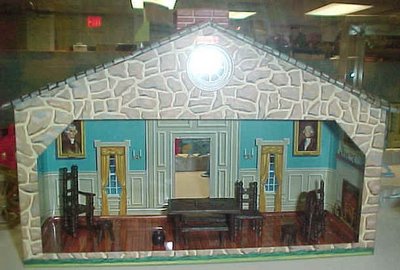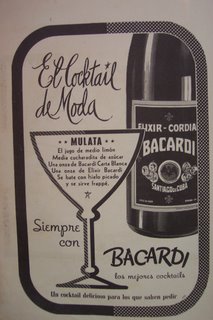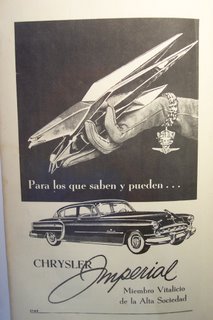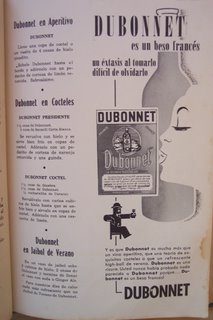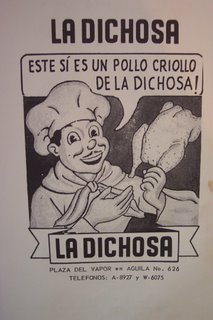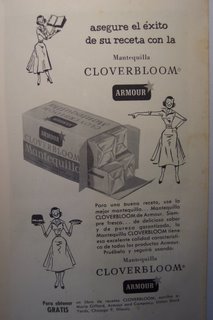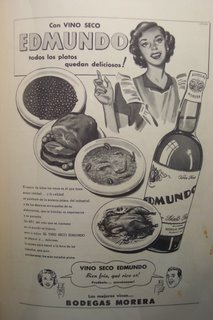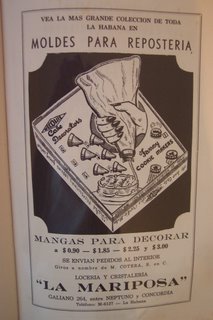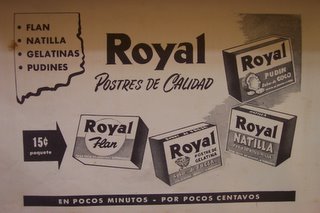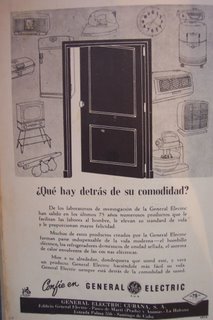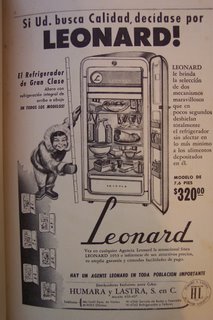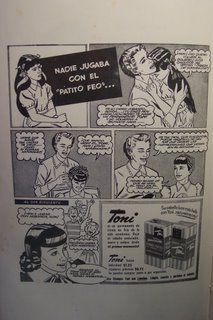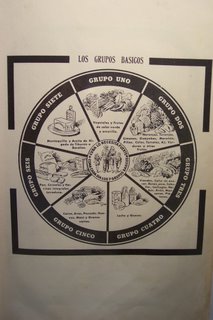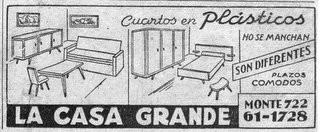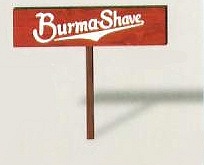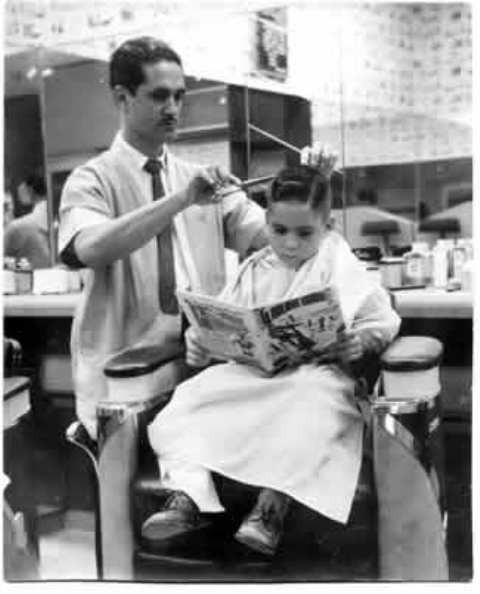Back to the Future!
Fooled you with the title? This isn't about movies involving mad professors who time-travel in flying Deloreans - in case you wonder "what is this, Delorean, you speak of?" It was the Edsel of the 80s...
We'll cut out the car talk and leave it for another day. We're not actually going to the future - we are going to the past, because sometimes you need to know where you've been before you understand where you are going - or where Havana could have been and become if not fated to be enveloped in darkness.
I am afraid this posting will have to be done in the manner and style of those old 50s' TV serials enjoyed in that decade, serials such as "Flash Gordon" and "Don Winslow, USN." Otherwise, fear the post would be a bit lengthy - besides, it is fun to bring out a sequel. Hollywood does it all the time, right? Actually, just because Hollywood does it don't make it right. One could do an entire blog on the fawning, groveling habits of certain "Hollywoodies" in the presence of a certain stinkin,' old bearded dinosaur. But we leave that to the Freudian psychologists.
The images of late 19th-early 20th century Cuba displayed here came courtesy of a long-gone, distant relative named Pedro Pablo Peralta, who collected and kept them until one day he gave them, or mailed them, to my great uncles, on my father's side, Alberto and Constantino Quiroga. Alberto and Constantino were Pedro Pablo's uncles. Who, in turn, passed them on to father, who in turn provides them here for your enjoyment.
Dad describes Pedro Pablo as a "Bohemian" type - we would have called him a "hippie" today. He eked out a living designing, making, and marketing hand-drawn and decorated cards, including Christmas and other kinds of greeting cards. He employed his calligraphic skills doing this, a sample of which you shall see soon enough. Regretfully, we have no samples of his other work, which in light of all the desktop-and-web-based designing and publishing tools available today, would have been something no doubt to admire, since real craftmanship was involved, not just an understanding of cut-n-paste.
He also wrote passable poetry, and, from father's recollection, frequented Havana poolhalls where he enjoyed the game - and placing bets. Somehow, he got by and enjoyed life well enough - until...well, that's in the past.
Where he obtained the photos featured here, taken between 1899-1903, we do not know. It is clear, however, he cherished them, and made sure they were passed on, not just buried and forgotten - maybe even destroyed - in a decaying Havana. We are fortunate that he annotated each and every one, giving location, names of buildings, sometimes throwing in a little historical detail or two. Which reminds me to remind you: Do this for every photo in your possession, no matter how trivial/unimportant you think the images are - it brings meaning and memory to each image, making each priceless. And we are not talking dollars and cents here. Does this make sense?
And now, courtesy Pedro Pablo Peralta Productions, and in his own words, presenting...

"Laying the cornerstone for the Center for Dependents (Centro de Dependientes) in 1902 - the honorable (although not specified, it appears the order is left-right) Joaquin de Freixas, Carlos M. de Cespedes, Juan R. O'Farril, Riuz Rivera, Emilio Nunez, Alejandro Rodriguez." Names of men who played their part in Cuba - and Havana's history; it would be impossible to tell what each did, or describe the significance of their contributions. Here is your opportunity to do some research and learn about them - curious?
Here is another image from the same event, which took place September 28, 1902. Cuba had become an independent republic earlier, on May 20, 1902. There are more names, and again, it appears the individuals named appear from left to right. I could be wrong, as on September 28, 1902 at best, I was a "work in progress"-or chaos-in God's mind...
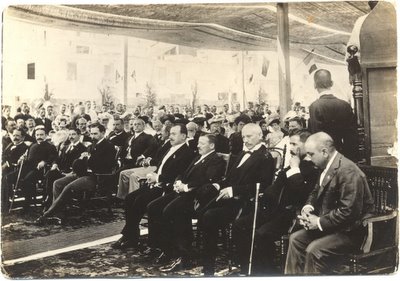
"Laying the cornerstone Center for Dependents; the honorable Carlos M. de Cespedes, Juan R. O'Farril, Emilio Nunez, Joaquin de Freixas, Romagosa, Riuz Rivera, Berrier, Valdez, Gonzalez de Mendoza, Manuel Garcia del Valle, Alejandro Rodriguez."
Of course, independent republics need an army and defense works, to protect their independence and keep order for the public good. At least that is the ideal role for a nation's armed forces.

"The first Cuban soldiers." They appear to be equipped with Mauser rifles, left over from the Spanish colonial army. But I could be mistaken - rifle experts out there may be able to help us. They do not appear to be Krag-Jorgensens, issued to American troops. The men look sharp, no? And probably sweltering under the tropical sun with their tight collars...we've come a long way in uniform design since then.
Havana harbor required suitable defensive works to stave off foreign foes - once before, in 1762, a British fleet brought an army which landed there and took the city. Sometimes, however, no defense can withstand enemies from within...these walls being silent witnesses to the worst enemies Havana ever had, back in January 1959...
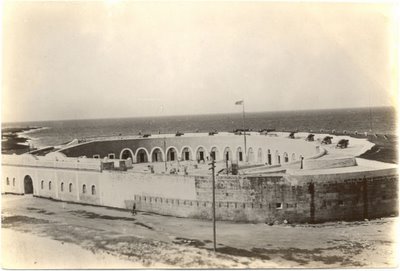
"The Queen's Battery (Bateria de La Reina) today Maceo Park." Here's an interesting bit of family lore, related by dad, the Living Encyclopedia of All Things Connected to The Quirogas in Cuba: his father, my grandfather Dario Quiroga, together with two other brothers, Alvaro and Nicanor, had left Spain sometime in 1897, to - am embarrassed to admit - avoid military service. In a way, can't say I blame them, as the war against the Cuban insurrectionists was going on, hot and strong, since 1895, no end in sight. The thought of facing machete-wielding "mambises" in the hot fields of Cuba was evidently not a palatable prospect.
For whatever reason, and the logic escapes me, that is, if you wanted to avoid fighting Cuban rebels, they went to...Cuba. Lo and behold, after being there for a while they were DRAFTED! And were forced to take the "King's shilling," or the "Queen's peseta," as the case may be. Grandfather got lucky - as he had flat feet, he was posted to artillery, and was sent to serve in an artillery battery at La Cabana fortress, guarding Havana harbor. He did not have to fire a shot at anyone, since, when the Americans landed in Cuba in 1898, most of the fighting took place far from Havana.
His brothers Alvaro and Nicanor were given their marching orders and sent to the infantry. Their feet were not flat. So, they became what today we call "ground pounders." They had a close call, when the troop train in which they were being transported to the fighting zone was derailed by Cuban rebels. Someone was looking out for them, however, as they suffered nary a scratch. And so, these three Quiroga brothers wound up serving honorably albeit on the wrong side, only for a short time, and best of all - getting out of the whole mess in one piece. Which may have made a difference as to whether or not this blogger would be here today writing about these things.
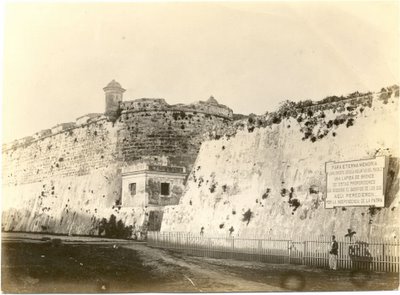
"Pit or fosse of the Laurels (Foso de los Laureles) - a place of execution for many Cuban patriots." And within those ominous-looking walls, many more Cuban patriots would fall, almost 60 years later, by firing squads commanded by barbarians clad in olive-green fatigues, many wearing crucifixes around their necks...as if symbolizing how they had come to crucify an entire people. The sign on the wall back then, circa 1902, read: "In Eternal Memory, and by the will of the People, will be affixed here a bronze plaque in the same proportions, to remember the sacrifice of those who perished here for the independence of the Homeland." The words ring as true today as they did then.
And speaking of visitors to Havana harbor, there was a certain ship...

"Remains of the battleship Maine - to the right, center, sargent York, later commander." Unfortunately, I cannot tell you what sargent York became commander of, later, except to say it would have been infantry. I can tell you he is not the same sargent Alvin York of Tennessee, who, in 1918, during the Great War-wars, by the way, are not great, although sometimes they are necessary-dispatched to Valhalla about a couple Baker's Dozen's worth of the Kaiser's boys with well-aimed shots from his '03 Springfield - earning a Congressional Medal of Honor in the process. For you Gary Cooper fans, he played sargent York in the movie by the same title, back in '41. Good movie too.

Pedro Pablo wrote on this one "Victims of the Maine." The photograph is of a cemetery - possibly, but without certainty, the big cemetery in Havana known as "Colon," where casualties of the battleship Maine, perishing in the explosion of February 1898, were buried. Serious and somber-looking US soldiers and Navy men pay homage to their comrades in arms; unfortunately, none of the men in the photograph, including the civilian, are identified.
Other famous-or infamous-ships paid visits to Havana harbor. One was the German Navy's Schleswig-Holstein, which paid a call in the spring of '39. Dad recalls seeing many German sailors on shore leave, some of whom, together with their officers, laid wreaths at a monument to Jose Marti, resulting in protests from anti-Nazi groups, offended by this gesture from Hitler's sailors. Too bad there weren't enough Habaneros to mount similarly vehement protests at the presence of Khruschev's Soviet sailors, not too many years afterwards...

The Schleswig-Holstein, as she would have appeared at the time of her Havana visit-from www.geocities.com/Pentagon/Quarters. Photo dates from 1937-1938.
And about five months later, at 04:47 AM on September 1, 1939 she became an instrument of the mad Fuehrer's plans for conquest and subjugation, when she became the first warship to fire her guns in anger, against shore positions in Polish Westerplatte...
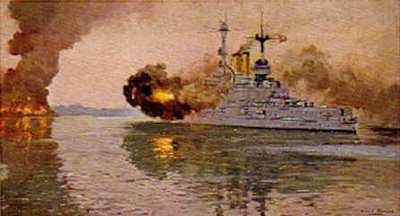
"Beschiessung der Westerplatte" (Bombardment of the Westerplatte) by Klaus Bergen, 1940-from www.thirdreichruins.com.
And then there was the tragic St. Louis in June 1939, ironically following the visit from Hitler's ship-bringing refugees trying to put an ocean between themselves and the mad Fuehrer, to no avail. Twenty years later, many Habaneros would themselves become refugees, trying to put at least 90 miles between themselves and the closet Hitler-lover of Havana...
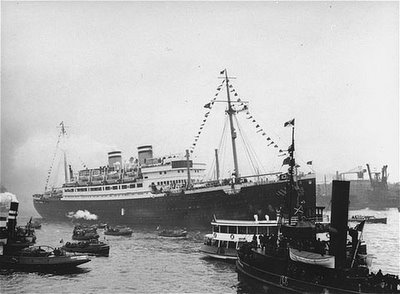
A view of the S.S. St. Louis surrounded by smaller vessels in the port of Havana (USHMM Photo)- www.jewishvirtuallibrary.org.
About mid-1957, a little boy beheld in awe, from his bedroom window at apartment 26L, Focsa building, a powerful, impressive United States Navy aircraft carrier. It may have been the USS Forrestal, CV-59. Unfortunately, the little boy's brain has grown older, not necessarily wiser - memory has dimmed here and there. It could have been another carrier. But he could not stop examining this magnificent ship, which he did in detail, thanks to his dad's telescope, aimed from the balcony towards the harbor. Later, he was thrilled to go on a small launch, with his dad and his cousin Fernando, circling the carrier, admiring it from all angles, impressed with its purposeful look. Years later, interestingly, the little boy was to marry a gal whose father was a Navy Man - a carrier man, indeed, having served on board the USS Lake Champlain, CV-39, during the Big One. That's World War II, for the history-impaired.
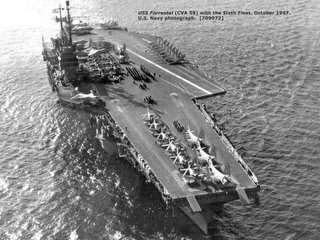
All these interesting historical connections and coincidences - how did we start with Havana and wind up talking about harbors and ships, famous and infamous? But in fact, the harbor made Havana, for better or worse; the harbor and its history cannot be ignored or glossed over.
Ships of peace, ships of war, ships of fools, ships of tragedy. Are we done with ships and their connection to the heart of Havana and its harbor? Not quite. There are two other classes of ship we must discuss: ships of Fate and Sinister ships.
On December 2, 1956 a small yacht with an innocuous name, "Granma," landed certain characters who would work their way to Havana a little over 2 years later, in Oriente province. A ship of Fate. A fatal Fate, for Havana and the rest of Cuba. The chain of consequences brought by that little boat, smaller than the Maine, very small compared to the Schleswig-Holstein and the St. Louis, extremely small, compared to the Forrestal, are being felt in Havana, the rest of Cuba, and indeed much of the world, almost 50 years later.
And the leader of that dastardly band once in power, began beefing up his military and internal terror apparatus, despite pious protestations that his intentions were peaceful, and Cuba needed no weapons. "Armas para que?," he would hypocritically proclaim - "Weapons, for what?" And in early March 1960, a Sinister ship entered Havana harbor. The ship was named "La Coubre," and it was filled to the bilges with weapons and explosives. Mysteriously, on March 4, 1960 the ship exploded violently; twice, in fact.

Aftermath-La Coubre explosions - Havana harbor, Friday March 4, 1960 - from CUBAN INFORMATION ARCHIVES - cuban-exile.com
A young boy, arriving at his grandmother Maria's place at the end of another week in Baldor Academy, remembers the black-and-white images of the destruction and carnage on TV. Images repeated and discussed, ad nauseam, by the news commentators, for hours and hours. Funny how, years later, so-called "mainstream media" in the USA have a predilection for also beating their subject to death, specially if by so doing they believe themselves to be advancing politically-correct agendas...
The bearded self-proclaimed leader, his followers and propaganda mouthpieces, for weeks afterwards, tried to portray the explosion as "sabotage," the United States directly and indirectly blamed for the alleged "sabotage." This became the pretext-under the guise that "the revolution was under attack by the Yankee imperialists"-used by the bearded one to seriously begin clamping down on the opposition, thus tightening the screws relentlessly, following his plan for the enslavement of the Cuban people. More and more, the USA would be turned into the "boogeyman" against whom all "revolutionary stalwarts" had to stand, firmly and fanatically. And so, the La Coubre's explosions signalled the implosion of Cuban society, shortly to be finally shattered and dismembered, and scattered to the winds.
You know what I think you did, you closet Hitler-lover of Havana? You contrived to have La Coubre blow up so you could have YOUR Reichstag Fire...
 The German Reichstag (Parliament) building burns, February 1933-from www.wwiivets.com
The German Reichstag (Parliament) building burns, February 1933-from www.wwiivets.comTo be continued...




